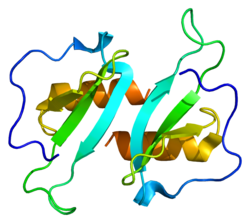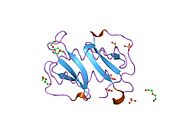Mammalian protein found in Homo sapiens
| CCL20 |
|---|
 |
| Available structures |
|---|
| PDB | Ortholog search: PDBe RCSB |
|---|
| List of PDB id codes |
|---|
2JYO, 1M8A, 2HCI |
|
|
| Identifiers |
|---|
| Aliases | CCL20, CKb4, Exodus, LARC, MIP-3-alpha, MIP-3a, MIP3A, SCYA20, ST38, chemokine (C-C motif) ligand 20, C-C motif chemokine ligand 20 |
|---|
| External IDs | OMIM: 601960 MGI: 1329031 HomoloGene: 3375 GeneCards: CCL20 |
|---|
| Gene location (Human) |
|---|
 | | Chr. | Chromosome 2 (human)[1] |
|---|
| | Band | 2q36.3 | Start | 227,805,739 bp[1] |
|---|
| End | 227,817,564 bp[1] |
|---|
|
| Gene location (Mouse) |
|---|
 | | Chr. | Chromosome 1 (mouse)[2] |
|---|
| | Band | 1 C5|1 42.69 cM | Start | 83,094,487 bp[2] |
|---|
| End | 83,096,888 bp[2] |
|---|
|
| RNA expression pattern |
|---|
| Bgee | | Human | Mouse (ortholog) |
|---|
| Top expressed in | - gallbladder
- secondary oocyte
- appendix
- rectum
- sperm
- periodontal fiber
- mucosa of urinary bladder
- thymus
- amniotic fluid
- palpebral conjunctiva
|
| | Top expressed in | - duodenum
- thymus
- jejunum
- colon
- trachea
- ileum
- lip
- left colon
- zone of skin
- stomach
|
| | More reference expression data |
|
|---|
| BioGPS |  | | More reference expression data |
|
|---|
|
| Gene ontology |
|---|
| Molecular function | - cytokine activity
- protein binding
- CCR6 chemokine receptor binding
- chemokine activity
- CCR chemokine receptor binding
| | Cellular component | - extracellular region
- intracellular anatomical structure
- extracellular space
| | Biological process | - monocyte chemotaxis
- positive regulation of T cell migration
- neutrophil chemotaxis
- positive regulation of ERK1 and ERK2 cascade
- positive regulation of GTPase activity
- positive regulation of nitric-oxide synthase biosynthetic process
- defense response to bacterium
- cell-cell signaling
- lymphocyte chemotaxis
- wound healing
- cellular response to lipoteichoic acid
- cellular response to tumor necrosis factor
- cellular response to organic substance
- chemokine-mediated signaling pathway
- cellular response to interleukin-1
- cellular response to interferon-gamma
- signal transduction
- immune response
- cellular response to lipopolysaccharide
- chemotaxis
- calcium-mediated signaling using intracellular calcium source
- cell chemotaxis
- T cell migration
- thymocyte migration
- inflammatory response
- antimicrobial humoral immune response mediated by antimicrobial peptide
- regulation of signaling receptor activity
- G protein-coupled receptor signaling pathway
- cytokine-mediated signaling pathway
| | Sources:Amigo / QuickGO |
|
| Orthologs |
|---|
| Species | Human | Mouse |
|---|
| Entrez | | |
|---|
| Ensembl | | |
|---|
| UniProt | | |
|---|
| RefSeq (mRNA) | | |
|---|
| RefSeq (protein) | | |
|---|
| Location (UCSC) | Chr 2: 227.81 – 227.82 Mb | Chr 1: 83.09 – 83.1 Mb |
|---|
| PubMed search | [3] | [4] |
|---|
|
| Wikidata |
| View/Edit Human | View/Edit Mouse |
|
Chemokine (C-C motif) ligand 20 (CCL20) or liver activation regulated chemokine (LARC) or Macrophage Inflammatory Protein-3 (MIP3A) is a small cytokine belonging to the CC chemokine family. It is strongly chemotactic for lymphocytes and weakly attracts neutrophils.[5] CCL20 is implicated in the formation and function of mucosal lymphoid tissues via chemoattraction of lymphocytes and dendritic cells towards the epithelial cells surrounding these tissues. CCL20 elicits its effects on its target cells by binding and activating the chemokine receptor CCR6.[6]
Gene expression of CCL20 can be induced by microbial factors such as lipopolysaccharide (LPS), and inflammatory cytokines such as tumor necrosis factor and interferon-γ, and down-regulated by IL-10.[7] CCL20 is expressed in several tissues with highest expression observed in peripheral blood lymphocytes, lymph nodes, liver, appendix, and fetal lung and lower levels in thymus, testis, prostate and gut.[5][8] The gene for CCL20 (scya20) is located on chromosome 2 in humans.[9]
Recent research [10] in an animal model of multiple sclerosis known as experimental autoimmune encephalitis (EAE) demonstrated that regional neural activation can create "gates" for pathogenic CD4+ T cells to enter the CNS by increasing CCL20 expression, especially at L5. Sensory nerve stimulation, elicited by using muscles in the leg or electrical stimulation as in Arima et al., 2012, activates sympathetic neurons whose axons run through the dorsal root ganglia containing cell bodies of the stimulated afferent sensory nerve. Sympathetic neuronal activity activates IL-6 amplifier resulting in increased regional CCL20 expression and subsequent pathogenic CD4+ T cell accumulation at the same spinal cord level. CCL20 expression was observed to be dependent on IL-6 amplifier activation, which is dependent on NF-κB and STAT3 activation. This research provides evidence for a critical role for CCL20 in autoimmune pathogenesis of the central nervous system.
References
- ^ a b c GRCh38: Ensembl release 89: ENSG00000115009 – Ensembl, May 2017
- ^ a b c GRCm38: Ensembl release 89: ENSMUSG00000026166 – Ensembl, May 2017
- ^ "Human PubMed Reference:". National Center for Biotechnology Information, U.S. National Library of Medicine.
- ^ "Mouse PubMed Reference:". National Center for Biotechnology Information, U.S. National Library of Medicine.
- ^ a b Hieshima K, Imai T, Opdenakker G, Van Damme J, Kusuda J, Tei H, Sakaki Y, Takatsuki K, Miura R, Yoshie O, Nomiyama H (1997). "Molecular cloning of a novel human CC chemokine liver and activation-regulated chemokine (LARC) expressed in liver. Chemotactic activity for lymphocytes and gene localization on chromosome 2". J. Biol. Chem. 272 (9): 5846–5853. doi:10.1074/jbc.272.9.5846. PMID 9038201.
- ^ Baba M, Imai T, Nishimura M, Kakizaki M, Takagi S, Hieshima K, Nomiyama H, Yoshie O (1997). "Identification of CCR6, the specific receptor for a novel lymphocyte-directed CC chemokine LARC". J. Biol. Chem. 272 (23): 14893–14898. doi:10.1074/jbc.272.23.14893. PMID 9169459.
- ^ Schutyser E, Struyf S, Menten P, Lenaerts JP, Conings R, Put W, Wuyts A, Proost P, Van Damme J (2000). "Regulated production and molecular diversity of human liver and activation-regulated chemokine/macrophage inflammatory protein-3 alpha from normal and transformed cells". J. Immunol. 165 (8): 4470–7. doi:10.4049/jimmunol.165.8.4470. PMID 11035086.
- ^ Rossi DL, Vicari AP, Franz-Bacon K, McClanahan TK, Zlotnik A (1997). "Identification through bioinformatics of two new macrophage proinflammatory human chemokines: MIP-3alpha and MIP-3beta". J. Immunol. 158 (3): 1033–6. doi:10.4049/jimmunol.158.3.1033. PMID 9013939. S2CID 39291729.
- ^ Nelson RT, Boyd J, Gladue RP, Paradis T, Thomas R, Cunningham AC, Lira P, Brissette WH, Hayes L, Hames LM, Neote KS, McColl SR (2001). "Genomic organization of the CC chemokine mip-3alpha/CCL20/larc/exodus/SCYA20, showing gene structure, splice variants, and chromosome localization". Genomics. 73 (1): 28–37. doi:10.1006/geno.2001.6482. PMID 11352563.
- ^ Regional Neural Activation Defines a Gateway for Autoreactive T Cells to Cross the Blood-Brain Barrier | author = Arima, Yasunobu; Harada, Masaya; Kamimura, Daisuke; Park, Jin-Haeng; Kawano, Fuminori; Yull, Fiona E.; Kawamoto, Tadafumi; Iwakura, Yoichiro; Betz, Ulrich A.K.; Marquez, Gabriel; Blackwell, Timothy S.; Ohira, Yoshinobu; Hirano, Toshio; Murakami, Masaaki | Cell doi:10.1016/j.cell.2012.01.022 (volume 148 issue 3 pp.447 - 457)
Further reading
- Matoba R, Okubo K, Hori N, et al. (1994). "The addition of 5'-coding information to a 3'-directed cDNA library improves analysis of gene expression". Gene. 146 (2): 199–207. doi:10.1016/0378-1119(94)90293-3. PMID 8076819.
- Rossi DL, Vicari AP, Franz-Bacon K, et al. (1997). "Identification through bioinformatics of two new macrophage proinflammatory human chemokines: MIP-3alpha and MIP-3beta". J. Immunol. 158 (3): 1033–6. doi:10.4049/jimmunol.158.3.1033. PMID 9013939. S2CID 39291729.
- Hieshima K, Imai T, Opdenakker G, et al. (1997). "Molecular cloning of a novel human CC chemokine liver and activation-regulated chemokine (LARC) expressed in liver. Chemotactic activity for lymphocytes and gene localization on chromosome 2". J. Biol. Chem. 272 (9): 5846–5853. doi:10.1074/jbc.272.9.5846. PMID 9038201.
- Hromas R, Gray PW, Chantry D, et al. (1997). "Cloning and characterization of exodus, a novel beta-chemokine". Blood. 89 (9): 3315–22. PMID 9129037.
- Baba M, Imai T, Nishimura M, et al. (1997). "Identification of CCR6, the specific receptor for a novel lymphocyte-directed CC chemokine LARC". J. Biol. Chem. 272 (23): 14893–14898. doi:10.1074/jbc.272.23.14893. PMID 9169459.
- Liao F, Alderson R, Su J, et al. (1997). "STRL22 is a receptor for the CC chemokine MIP-3alpha". Biochem. Biophys. Res. Commun. 236 (1): 212–217. doi:10.1006/bbrc.1997.6936. PMID 9223454.
- Power CA, Church DJ, Meyer A, et al. (1997). "Cloning and characterization of a specific receptor for the novel CC chemokine MIP-3alpha from lung dendritic cells". J. Exp. Med. 186 (6): 825–835. doi:10.1084/jem.186.6.825. PMC 2199050. PMID 9294137.
- Tanaka Y, Imai T, Baba M, et al. (1999). "Selective expression of liver and activation-regulated chemokine (LARC) in intestinal epithelium in mice and humans". Eur. J. Immunol. 29 (2): 633–642. doi:10.1002/(SICI)1521-4141(199902)29:02<633::AID-IMMU633>3.0.CO;2-I. PMID 10064080.
- Yang D, Howard OM, Chen Q, Oppenheim JJ (1999). "Cutting edge: immature dendritic cells generated from monocytes in the presence of TGF-beta 1 express functional C-C chemokine receptor 6". J. Immunol. 163 (4): 1737–41. doi:10.4049/jimmunol.163.4.1737. PMID 10438902. S2CID 14563599.
- Yang D, Chertov O, Bykovskaia SN, et al. (1999). "Beta-defensins: linking innate and adaptive immunity through dendritic and T cell CCR6". Science. 286 (5439): 525–528. doi:10.1126/science.286.5439.525. PMID 10521347.
- Charbonnier AS, Kohrgruber N, Kriehuber E, et al. (2000). "Macrophage inflammatory protein 3alpha is involved in the constitutive trafficking of epidermal langerhans cells". J. Exp. Med. 190 (12): 1755–1768. doi:10.1084/jem.190.12.1755. PMC 2195721. PMID 10601351.
- Schutyser E, Struyf S, Menten P, et al. (2000). "Regulated production and molecular diversity of human liver and activation-regulated chemokine/macrophage inflammatory protein-3 alpha from normal and transformed cells". J. Immunol. 165 (8): 4470–7. doi:10.4049/jimmunol.165.8.4470. PMID 11035086.
- Hirose J, Kawashima H, Yoshie O, et al. (2001). "Versican interacts with chemokines and modulates cellular responses". J. Biol. Chem. 276 (7): 5228–5234. doi:10.1074/jbc.M007542200. PMID 11083865.
- Nakayama T, Fujisawa R, Yamada H, et al. (2001). "Inducible expression of a CC chemokine liver- and activation-regulated chemokine (LARC)/macrophage inflammatory protein (MIP)-3 alpha/CCL20 by epidermal keratinocytes and its role in atopic dermatitis". Int. Immunol. 13 (1): 95–103. doi:10.1093/intimm/13.1.95. PMID 11133838.
- Nelson RT, Boyd J, Gladue RP, et al. (2001). "Genomic organization of the CC chemokine mip-3alpha/CCL20/larc/exodus/SCYA20, showing gene structure, splice variants, and chromosome localization". Genomics. 73 (1): 28–37. doi:10.1006/geno.2001.6482. PMID 11352563.
- Tohyama M, Shirakara Y, Yamasaki K, et al. (2001). "Differentiated keratinocytes are responsible for TNF-alpha regulated production of macrophage inflammatory protein 3alpha/CCL20, a potent chemokine for Langerhans cells". J. Dermatol. Sci. 27 (2): 130–139. doi:10.1016/S0923-1811(01)00127-X. PMID 11532377.
- Giannini SL, Hubert P, Doyen J, et al. (2002). "Influence of the mucosal epithelium microenvironment on Langerhans cells: implications for the development of squamous intraepithelial lesions of the cervix". Int. J. Cancer. 97 (5): 654–659. doi:10.1002/ijc.10084. PMID 11807793. S2CID 24940837.
- Casamayor-Pallejà M, Mondière P, Verschelde C, et al. (2002). "BCR ligation reprograms B cells for migration to the T zone and B-cell follicle sequentially". Blood. 99 (6): 1913–1921. doi:10.1182/blood.V99.6.1913. PMID 11877260.
- Schmuth M, Neyer S, Rainer C, et al. (2002). "Expression of the C-C chemokine MIP-3 alpha/CCL20 in human epidermis with impaired permeability barrier function". Exp. Dermatol. 11 (2): 135–142. doi:10.1034/j.1600-0625.2002.110205.x. PMID 11994140. S2CID 40953753.
- Liao F, Shirakawa AK, Foley JF, et al. (2002). "Human B cells become highly responsive to macrophage-inflammatory protein-3 alpha/CC chemokine ligand-20 after cellular activation without changes in CCR6 expression or ligand binding". J. Immunol. 168 (10): 4871–80. doi:10.4049/jimmunol.168.10.4871. PMID 11994436.
External links
|
|---|
| By family | |
|---|
By function/
cell | |
|---|

 1m8a: Human MIP-3alpha/CCL20
1m8a: Human MIP-3alpha/CCL20 2hci: Structure of Human Mip-3a Chemokine
2hci: Structure of Human Mip-3a Chemokine

















